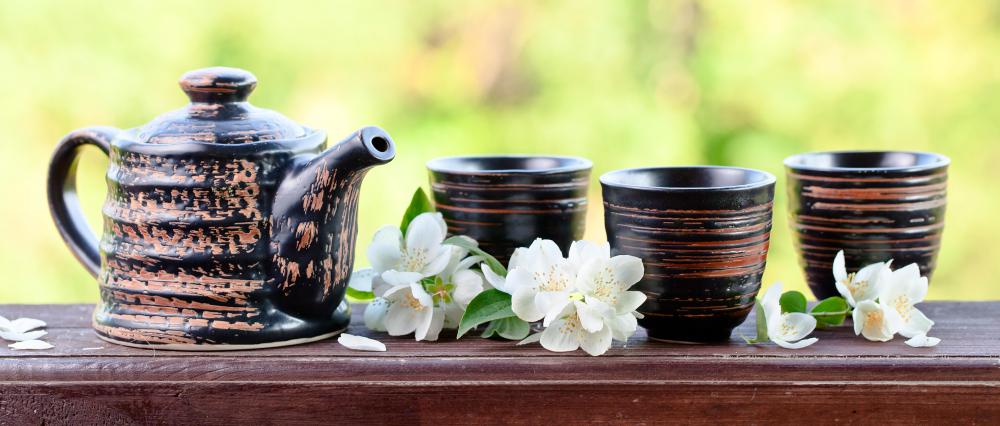At HomeQuestionsAnswered, we're committed to delivering accurate, trustworthy information. Our expert-authored content is rigorously fact-checked and sourced from credible authorities. Discover how we uphold the highest standards in providing you with reliable knowledge.
What Are the Different Jasmine Varieties?
Jasmine plants are available for a range of growing conditions. This genus, Jasminum, is comprised of 200 individual species, includes frost-tender tropicals and cold-hardy varieties. There are deciduous, evergreen and semi-evergreen jasmine plants, with the flower scent ranging from intense to none at all. Not all of the 200 species are commonly cultivated or available, but there is a wide range from which to choose. The three most commonly cultivated jasmine varieties are common jasmine, winter jasmine and Arabic jasmine.
Common jasmine, also called poets jasmine, is one of the semi-hardy jasmine varieties and has white or pale pink flowers. The flowers bloom seasonally and give off an intense tropical floral scent. Common jasmine grows in areas where winter temperatures rarely drop below 10°F (about -12°C). This climbing vine is well suited for growing over a trellis or up a wall near doorways and patio areas where the fragrant flowers can be enjoyed. This variety can be found under the species name Jasminum officinale.

Winter jasmine is a variety that is commonly cultivated in cooler climates. The yellow flowers bloom in spring and have no scent. This variety can tolerate winter temperatures down to 0°F (about -17°C). Winter jasmine is cold hardy, but it does benefit from some protection from cold winter weather and appreciates as much sun in winter as possible. This climbing vine variety is known by the species name Jasminum nudiflorum.

Arabic jasmine grows in tropical and sub-tropical areas where winter temperatures rarely drop below 30°F (about -1°C). It is a mid-size shrub with evergreen leaves and white fragrant flowers. In cold climates, Arabic jasmine, also known by its species name Jasminum sambac, can be grown as a houseplant in a sunny spot during the winter and moved outside in spring when the weather warms up.

Other jasmine varieties with scented fragrant flowers include Spanish jasmine and Italian jasmine. Italian jasmine is an evergreen plant that grows in a large sprawling shrub-like habit while Spanish jasmine is a deciduous climbing vine. Other jasmine varieties with unscented or mild scented flowers include primrose jasmine, grown for its large yellow flowers, and downey jasmine, cultivated for its gray-green leaves and snowy white flowers.

True jasmine varieties belongs to the Oleaceae, or olive plant, family. There are other plants that are called jasmine as well, often in reference to particularly fragrant flowers. Star jasmine, for instance, belongs to the Apocynaceae, or dogbane, family. This evergreen vine has white star-shaped flowers. West Indian jasmine, also commonly called plumeria, is a tropical shrub in the Apocynaceae family with waxy scented flowers.
AS FEATURED ON:
AS FEATURED ON:














Discussion Comments
@bear78-- Yes there are many varieties and they all look a bit different. There are some commonalities among the varieties as well. For example, most are vines with small white flowers. Jasmine varieties love warm/hot weather and they don't need a lot of water or shade. They tend to grow quickly and are often resistant to diseases.
Some varieties however have different sized flowers in colors like yellow. Some look less like a vine and more like a shrub. And the flowers may be larger/smaller with different numbers of petals.
But they're all very beautiful and look great in the garden or in a pot inside the home.
@bear78-- I'm not sure but the Indian jasmine, Arabian jasmine and the jasmine varieties that grow on the Mediterranean are all very fragrant. I assume that the Indian and Arabian jasmine are the most fragrant because they are used mostly in perfume making. In fact, in India, women often wear fresh jasmine in their hair to perfume their hair and surroundings.
There are also some vines and shrubs that have "jasmine" in their name but are not in the jasmine genus. For example, star jasmine and Madagascar jasmine. These varieties have little to no fragrance.
I didn't realize that there are so many different jasmine varieties.
So which jasmine is the most fragrant of them all?
Post your comments